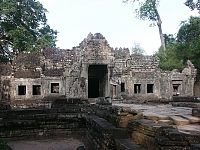
|
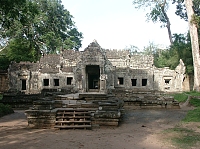
|
West entrance (gopura), third enclosure This entrance has a shallow porch with four pillars and a carved pediment. The interior is a cruciform-shaped room flanked by two additional rooms on the north and south--although the only openings are to the east and west. |
| |
|

|
Portal of the west entrance, third enclosureIn front of the entrance are two large sandstone dvarapalas (temple guardians) which are now headless. The pediment tells the story of the battle of Lanka, from the Ramayana, a classical Sanskrit epic of India, probably composed in the third century B.C.E. This epic relates the adventures of Rama, who with his three half brothers, comprised the seventh incarnation of the Hindu god Vishnu. Rama lost the throne of Ayodhya and was forced into a long exile with his wife, Sita. Later when Sita was abducted by a demon, Rama formed an alliance with the king of the monkeys whose general, Hanuman, fought an epic battle in Lanka (Sri Lanka). Eventually, Sita was restored to her husband, and Rama regained his kingdom. This story is also narrated on the north facade of the third gallery at Angkor Wat. |
| |
|
Epic battle in Lanka |
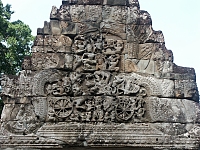
|
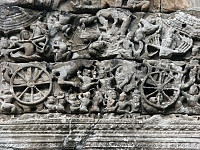
|
| |
|
Right: laterite enclosure wallLaterite, a red stone containing aluminum oxide and iron, is local to the area. Dug from the ground it is soft and easy to cut but when exposed to the air, it hardens and small cavities form, so that it cannot be carved. While sandstone was used more often for walls and carved areas, laterite was used for enclosure walls and retaining walls for the bases of buildings. |
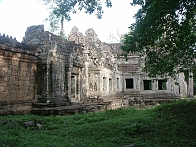
|
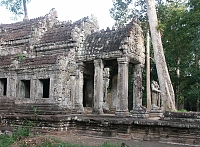
|
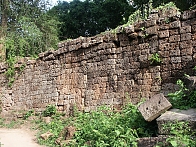
|
| |
|
Inner courtyardFallen masonry in many of the courtyards makes exploration somewhat dangerous. Devatas (or female deities) decorate many of the walls. |
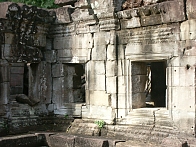
|

|
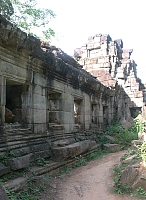
|
| |
|
Central sanctuaryThe linga on its yoni pedestal was probably placed in the temple in the second half of the 13th century. |

|
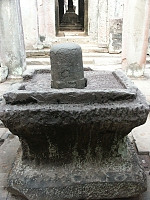
|
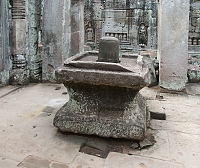
|
| |
|
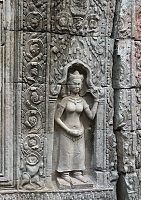
|

|
Relief decorations |
| |
|
Hermits in prayer--relief decoration |
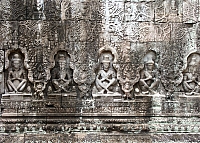
|

|


 Click here to go to the Cambodia Index.
Click here to go to the Cambodia Index. Click here to return to index of art historical sites.
Click here to return to index of art historical sites.
 Click here to return to index of artists and architects.
Click here to return to index of artists and architects.
 Click here to return to chronological index.
Click here to return to chronological index.
 Click here to see the home page of Bluffton University.
Click here to see the home page of Bluffton University.
